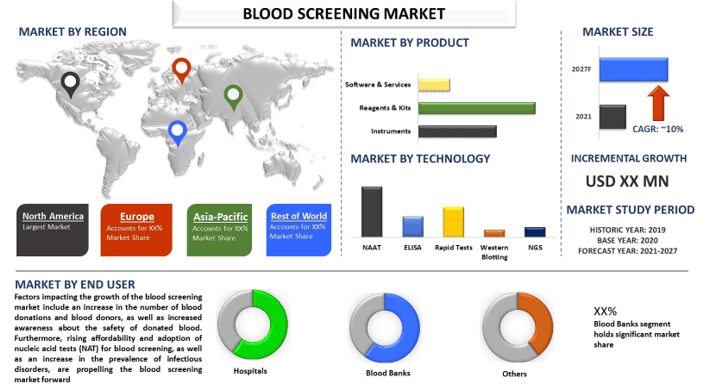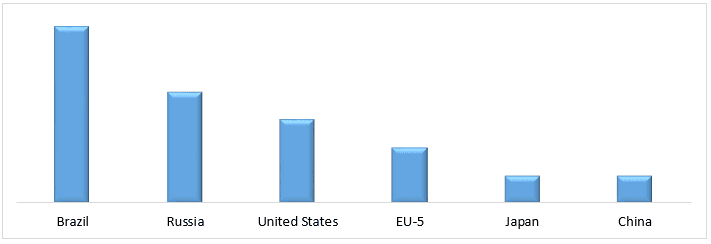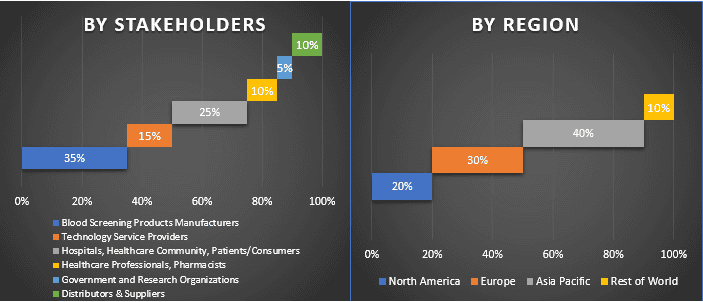血液スクリーニング市場:現状分析と予測(2021年~2027年)
製品の重視 (試薬 & キット、機器、ソフトウェア & サービス); 技術 (核酸増幅法 (NAAT)、酵素免疫測定法 (ELISA)、迅速検査、ウェスタンブロッティング、次世代シーケンシング (NGS)); エンドユーザー (病院、血液バンク、その他); 地域/国

血液スクリーニング市場は、予測期間(2021年~2027年)に年平均成長率(CAGR)約10%で成長すると予測されています。血液スクリーニングは、数多くの感染症を診断するための最も好ましい技術です。血液スクリーニングにより、医師は病気を正確に診断でき、適切な薬の投与と患者のモニタリングを支援して、病気の蔓延を防ぐことができます。市場は、献血と輸血関連検査の増加、感染症の頻度の増加、高齢者人口の増加、および輸血による感染症への意識の高まりなどの要因によって牽引されています。
新規感染症の発生率の上昇、高度な技術開発への投資レベルの上昇、および血液スクリーニングに関する有利な政府規制は、血液スクリーニング市場の拡大を加速させる可能性があります。一方、拡大するヘルスケア業界は、技術の進歩と相まって、さまざまな見通しを促進し、予測期間中の血液スクリーニング市場の隆盛をもたらすでしょう。さらに、血液サンプリングに関連する高コストは、予測期間中の血液スクリーニング市場の成長を制限すると予想されます。
選択された国における診断された感染症の有病率(%)、2019年

市場で事業を展開している主要なプレーヤーには、Abbott Laboratories、Bio-Rad Laboratories, Inc.、F. Hoffmann-La Roche Ltd.、Becton, Dickinson And Company、Thermo Fisher Scientific Inc.、bioMerieux, Inc.、Grifols, S.A.、Danaher Corporation、Boster Biological Technology、Demeditec Diagnostics GmbHなどがあります。これらのプレーヤーは、さまざまな地域でのプレゼンスを高めるために、いくつかのM&Aやパートナーシップを実施しています。
レポートで提示されたインサイト
「製品別では、試薬およびキットセグメントが2020年に市場を支配」
製品に基づいて、血液スクリーニング市場は、試薬およびキット、機器、ソフトウェアおよびサービスに分割されます。2020年には、試薬およびキットのカテゴリが、世界の血液スクリーニング市場の最大の割合を占めました。試薬は、経常的なコストを構成するため、免疫測定法および分子診断法で頻繁に使用されます。この市場の拡大は、献血および輸血関連のスクリーニングの増加、ならびに世界的な感染症および慢性疾患の有病率の上昇などの要因によって促進されています。
「技術別では、核酸増幅法(NAAT)セグメントが2020年に市場を支配。」
技術に基づいて、血液スクリーニング市場は、核酸増幅法(NAAT)、酵素結合免疫吸着測定法(ELISA)、迅速検査、ウェスタンブロッティング、次世代シーケンシング(NGS)に分類されます。2020年には、核酸増幅法(NAAT)のカテゴリが、世界の血液スクリーニング市場の最大の割合を占めました。この技術の早期発見のための高い感度と特異性などの優れた利点が、シェアのほとんどを占めています。
「エンドユーザー別では、血液バンクが2020年に大きな市場シェアを保持。」
エンドユーザーに基づいて、血液スクリーニング市場は、病院、血液バンク、その他に分類されます。血液スクリーニングの市場は、血液バンクセグメントによって支配されていました。献血された血液および血液製剤における感染症の検査室検査は、患者を保護し、危険な感染症の蔓延を防ぐための重要な安全対策です。このセグメントの成長は、献血および輸血関連検査の増加、輸血による感染症の認識の拡大、および感染症の発生率の上昇などの要因によって促進されています。
「北米が最大の市場として存在。」
血液スクリーニングの市場採用をより良く理解するために、市場は、北米(米国、カナダ、北米の残りの部分)、ヨーロッパ(ドイツ、英国、フランス、イタリア、スペイン、ヨーロッパの残りの部分)、アジア太平洋(中国、日本、インド、オーストラリア、APACの残りの部分)、および世界の残りの部分などの国について分析されます。北米は2020年に市場を支配しました。北米の血液スクリーニング市場を牽引する要因には、献血への意識の高まり、感染症の発生率の増加、新しい病原体の発生率の増加、およびこの地域の主要なプレーヤーの存在を含む、病院および科学研究所向けのハイエンドインフラストラクチャの存在が含まれます。
このレポートを購入する理由:
- この調査には、認証された主要な業界の専門家によって検証された市場規模の測定および予測分析が含まれています
- このレポートでは、業界全体のパフォーマンスの概要を一目で確認できます
- このレポートは、主要なビジネス財務、製品ポートフォリオ、拡張戦略、および最近の開発に焦点を当てた、著名な業界の同業他社の詳細な分析を網羅しています
- 業界で普及している推進要因、制約、主要な傾向、および機会の詳細な調査
- この調査では、さまざまなセグメントにわたる市場を包括的に網羅しています
- 業界の地域および国レベルの詳細な分析
カスタマイズオプション:
血液スクリーニング市場は、要件またはその他の市場セグメントに応じて、さらにカスタマイズできます。これに加えて、UMIは、お客様独自のビジネスニーズがあることを理解しています。お客様の要件に完全に適合するレポートを入手するために、お気軽にお問い合わせください。
目次
血液スクリーニング市場の過去の市場分析、現在の市場の推定、将来の市場予測は、世界のさまざまな地域における血液スクリーニング製品と技術の導入状況を作成および分析するために行われた3つの主要なステップでした。過去の市場数値を収集し、現在の市場規模を推定するために、徹底的な二次調査が実施されました。次に、これらの洞察を検証するために、多数の調査結果と仮定が考慮されました。さらに、業界のバリューチェーン全体にわたる業界の専門家との徹底的な一次インタビューが実施されました。一次インタビューを通じて市場数値を仮定および検証した後、トップダウン/ボトムアップアプローチを採用して、完全な市場規模を予測しました。その後、市場の内訳とデータ三角測量法を採用して、業界が関係するセグメントとサブセグメントの市場規模を推定および分析しました。詳細な方法論は以下で説明します。
過去の市場規模の分析
ステップ1:二次情報源の詳細な調査:
年次報告書と財務諸表、投資家向けプレゼンテーション、プレスリリースなどの企業内部情報源、およびジャーナル、ニュースと記事、政府刊行物、競合他社の刊行物、セクターレポート、サードパーティデータベース、その他の信頼できる刊行物などの外部情報源を通じて、血液スクリーニングの過去の市場規模を取得するために、詳細な二次調査が実施されました。
ステップ2:市場セグメンテーション:
血液スクリーニングの過去の市場規模を取得した後、主要地域のさまざまなセグメントとサブセグメントに関する過去の市場の洞察とシェアを収集するために、詳細な二次分析を実施しました。レポートに含まれる主要なセグメントは、製品別、技術別、およびエンドユーザー別です。さらに、地域および国レベルの分析を実施して、グローバルな状況における血液スクリーニング市場の全体的な採用状況を評価しました。
ステップ3:要因分析:
さまざまなセグメントとサブセグメントの過去の市場規模を取得した後、現在の市場規模を推定するために、詳細な要因分析を実施しました。さらに、献血と輸血関連スクリーニングの増加、感染症の有病率の増加など、従属変数と独立変数を使用して要因分析を実施しました。過去の傾向と市場規模とシェアに対する毎年の影響を分析しました。需要と供給のシナリオも徹底的に調査されました。
現在の市場規模の推定と予測
現在の市場規模の算定:上記の3つのステップからの実用的な洞察に基づいて、現在の市場規模、市場の主要なプレーヤー、およびセグメントと企業の市場シェアに到達しました。必要なすべてのパーセンテージ分割と市場の内訳は、上記の二次的なアプローチを使用して決定され、一次インタビューを通じて検証されました。
推定と予測:市場の推定と予測のために、推進要因とトレンド、制約、および利害関係者が利用できる機会を含むさまざまな要因に重みが割り当てられました。これらの要因を分析した後、関連する予測手法、つまりトップダウン/ボトムアップアプローチを適用して、世界の主要地域全体のさまざまなセグメントとサブセグメントの2027年までの市場予測に到達しました。市場規模を推定するために採用された調査方法論は以下を含みます:
- 主要市場における血液スクリーニングの価値(米ドル)および採用率の観点からの業界の市場規模
- 市場セグメントとサブセグメントのすべてのパーセンテージシェア、分割、および内訳
- 提供される製品の観点からの血液スクリーニング市場の主要なプレーヤー。また、急速に成長している市場で競争するためにこれらのプレーヤーが採用した成長戦略。
市場規模とシェアの検証
一次調査:主要国全体のトップレベルのエグゼクティブ(CXO/VP、営業部長、マーケティング部長、運営部長、および地域部長、カントリーヘッドなど)を含む主要なオピニオンリーダー(KOL)との詳細なインタビューが実施されました。次に、一次調査の結果が要約され、統計分析が実行されて、述べられた仮説が証明されました。一次調査からの入力は二次的な調査結果と統合され、情報が実用的な洞察に変わりました。
さまざまな地域における一次参加者の分割

市場エンジニアリング
データ三角測量法を採用して、全体的な市場の推定を完了し、血液スクリーニング市場の各セグメントとサブセグメントの正確な統計数値に到達しました。データは、世界の主要な国/地域の製品、技術、およびエンドユーザーの分野におけるさまざまなパラメータとトレンドを調査した後、いくつかのセグメントとサブセグメントに分割されました。
血液スクリーニング市場調査の主な目的
血液スクリーニングの現在および将来の市場トレンドは、調査で特定されました。投資家は、調査で実施された定性的および定量的分析から、投資に関する裁量を判断するための戦略的な洞察を得ることができます。現在および将来の市場トレンドは、地域および国レベルでの市場の全体的な魅力を決定し、最初の参入者の利点として利益を得るために、産業参加者が未開拓の市場を活用するためのプラットフォームを提供します。調査の他の定量的な目標には以下が含まれます:
- 価値(米ドル)の観点から、血液スクリーニングの現在および予測の市場規模を分析します。また、さまざまなセグメントとサブセグメントの現在および予測の市場規模を分析します
- 調査のセグメントには、製品、技術、およびエンドユーザーが含まれます
- 主要な地域および国における血液スクリーニングの現在および予測の市場規模を分析します
- レポートで調査された主要な地域には、北米(米国、カナダ、北米の残りの地域)、ヨーロッパ(ドイツ、英国、フランス、イタリア、スペイン、ヨーロッパの残りの地域)、アジア太平洋地域(中国、日本、インド、オーストラリア、アジア太平洋地域の残りの地域)、および世界の残りの地域が含まれます
- 血液スクリーニング市場のプレーヤーの企業プロファイルと、急速に成長している市場で持続するために採用した成長戦略
- 業界の詳細な地域および国レベルの分析
関連 レポート
この商品を購入したお客様はこれも購入しました










